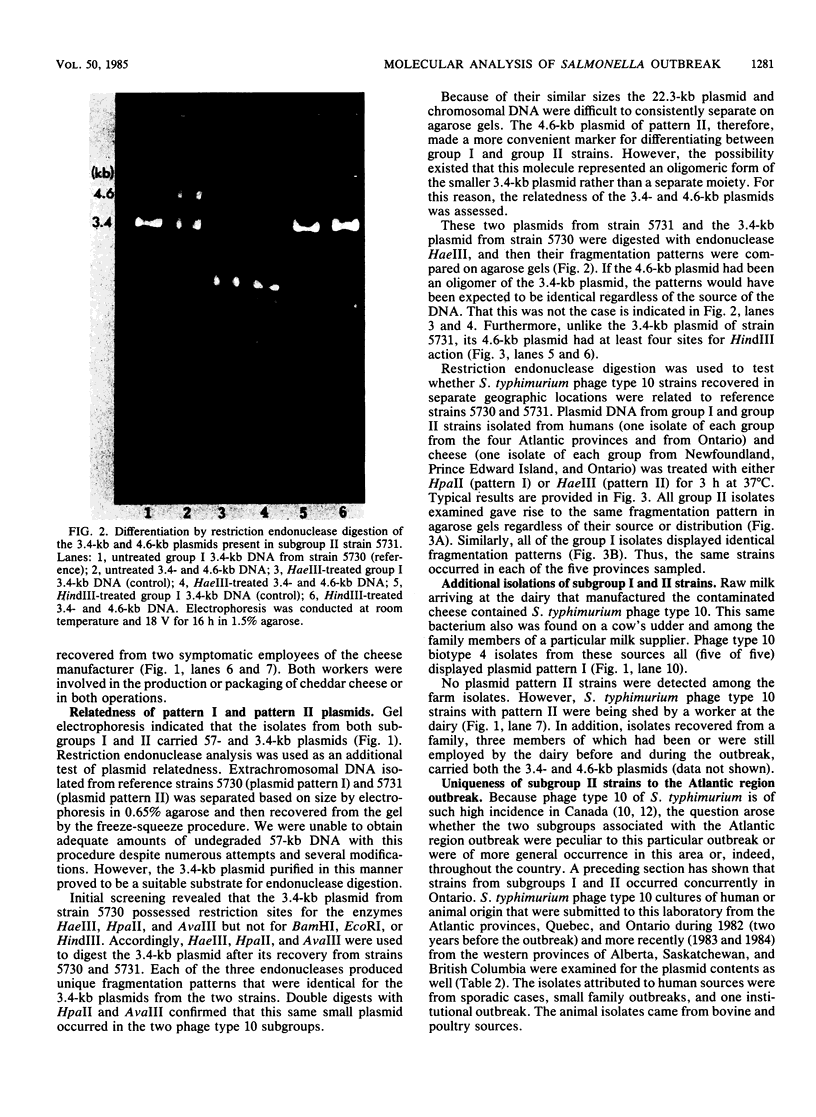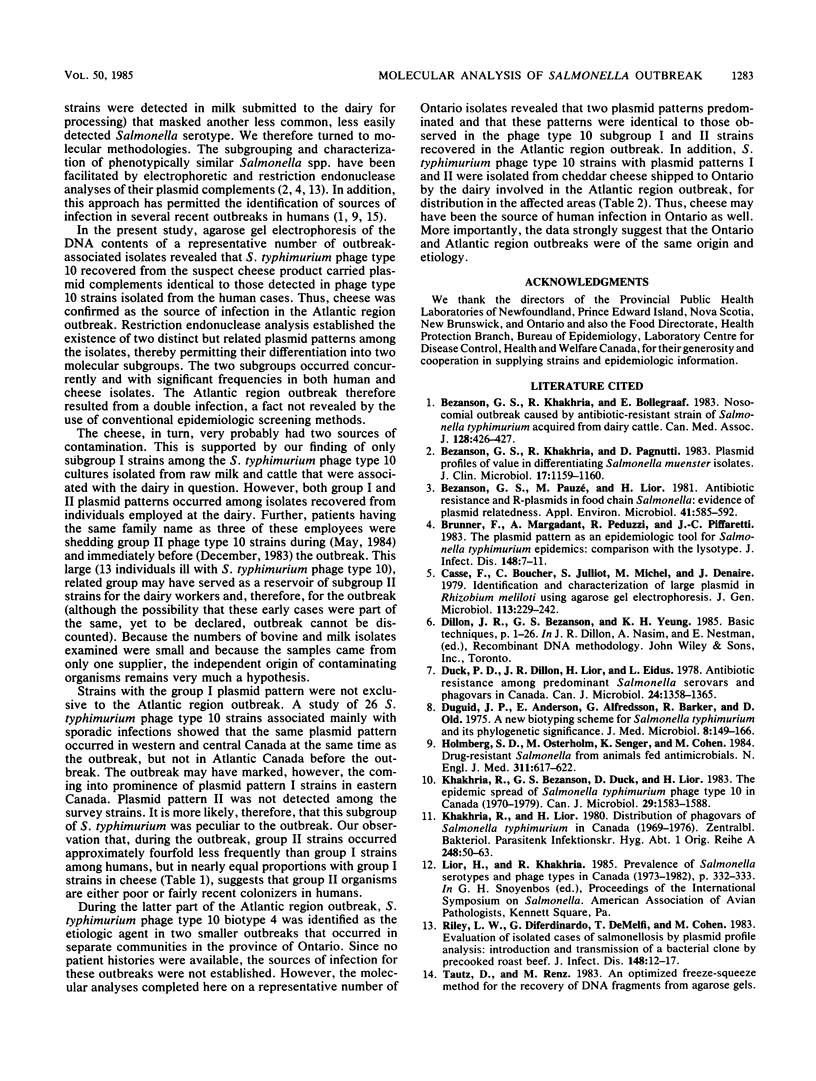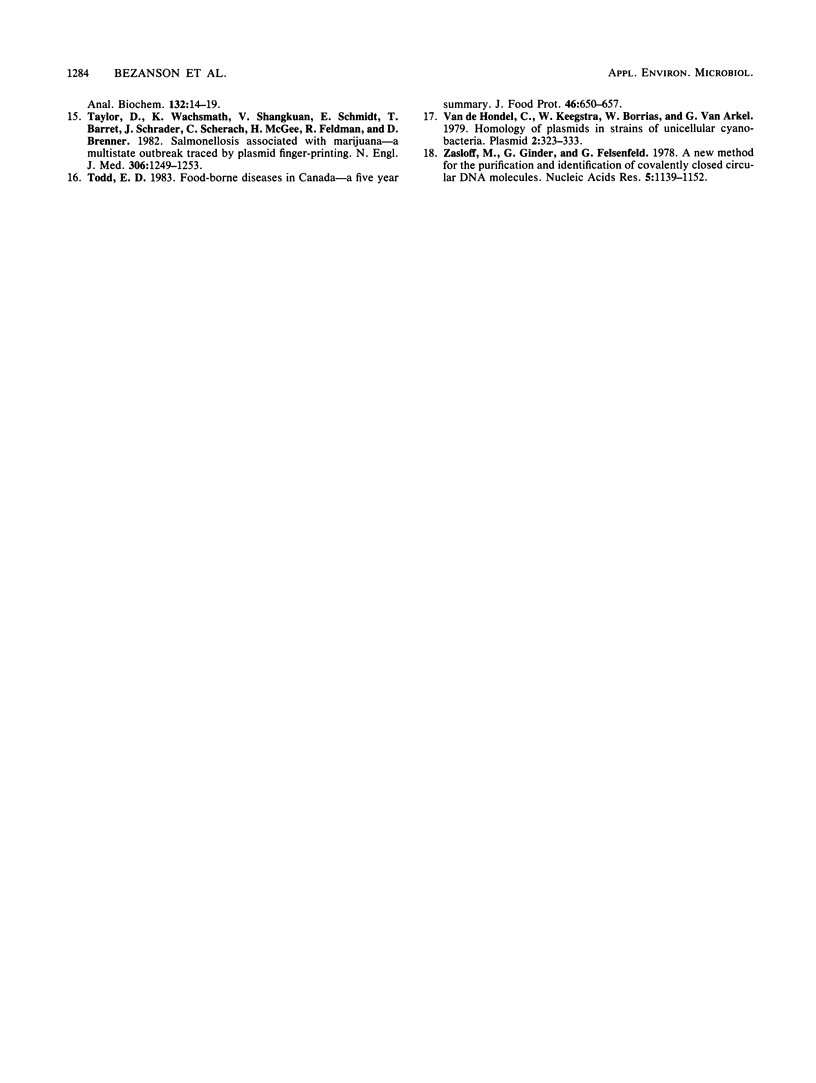Abstract
More than 2,000 confirmed cases of food poisoning occurred in the four Atlantic provinces of Canada and in Ontario during the second and third quarters of 1984. Salmonella typhimurium phage type 10 was identified as the etiologic agent, and cheddar cheese was implicated as the source of infection. Strains isolated from infected humans and from cheese were indistinguishable by biotyping, antibiotic resistance typing, and phage typing. Plasmid analysis confirmed cheese as the source of infection and revealed the presence of two molecular subgroups of bacteriophage type 10. Group I strains carried 57-, 22.3-, and 3.4-kilobase (kb) plasmids; group II strains carried 57-, 4.6-, and 3.4-kb plasmids. Digestion with endonucleases HaeIII, HpaII, and AvaIII indicated that the 3.4-kb plasmids were identical. This outbreak was, therefore, caused by a mixed infection with two distinct but related bacteria. Group I strains are fairly common among Canadian S. typhimurium phage type 10 isolates, whereas group II strains appeared to be unique to this outbreak.
Full text
PDF





Images in this article
Selected References
These references are in PubMed. This may not be the complete list of references from this article.
- Bezanson G. S., Khakhria R., Bollegraaf E. Nosocomial outbreak caused by antibiotic-resistant strain of Salmonella typhimurium acquired from dairy cattle. Can Med Assoc J. 1983 Feb 15;128(4):426–427. [PMC free article] [PubMed] [Google Scholar]
- Bezanson G. S., Khakhria R., Pagnutti D. Plasmid profiles of value in differentiating Salmonella muenster isolates. J Clin Microbiol. 1983 Jun;17(6):1159–1160. doi: 10.1128/jcm.17.6.1159-1160.1983. [DOI] [PMC free article] [PubMed] [Google Scholar]
- Bezanson G. S., Pauzé M., Lior H. Antibiotic resistance and R-plasmids in food chain Salmonella: evidence of plasmid relatedness. Appl Environ Microbiol. 1981 Mar;41(3):585–592. doi: 10.1128/aem.41.3.585-592.1981. [DOI] [PMC free article] [PubMed] [Google Scholar]
- Brunner F., Margadant A., Peduzzi R., Piffaretti J. C. The plasmid pattern as an epidemiologic tool for Salmonella typhimurium epidemics: comparison with the lysotype. J Infect Dis. 1983 Jul;148(1):7–11. doi: 10.1093/infdis/148.1.7. [DOI] [PubMed] [Google Scholar]
- Duck P. D., Dillon J. R., Lior H., Eidus L. Antibiotic resistance among predominant Salmonella serovars and phagovars in Canada. Can J Microbiol. 1978 Nov;24(11):1358–1365. doi: 10.1139/m78-218. [DOI] [PubMed] [Google Scholar]
- Duguid J. P., Anderson E. S., Alfredsson G. A., Barker R., Old D. C. A new biotyping scheme for Salmonella typhimurium and its phylogenetic significance. J Med Microbiol. 1975 Feb;8(1):149–166. doi: 10.1099/00222615-8-1-149. [DOI] [PubMed] [Google Scholar]
- Holmberg S. D., Osterholm M. T., Senger K. A., Cohen M. L. Drug-resistant Salmonella from animals fed antimicrobials. N Engl J Med. 1984 Sep 6;311(10):617–622. doi: 10.1056/NEJM198409063111001. [DOI] [PubMed] [Google Scholar]
- Khakhria R., Bezanson G., Duck D., Lior H. The epidemic spread of Salmonella typhimurium phage type 10 in Canada (1970-1979). Can J Microbiol. 1983 Nov;29(11):1583–1588. doi: 10.1139/m83-241. [DOI] [PubMed] [Google Scholar]
- Khakhria R., Lior H. Distribution of phagovars of Salmonella typhimurium in Canada (1969-1976). Zentralbl Bakteriol A. 1980;248(1):50–63. [PubMed] [Google Scholar]
- Riley L. W., DiFerdinando G. T., Jr, DeMelfi T. M., Cohen M. L. Evaluation of isolated cases of salmonellosis by plasmid profile analysis: introduction and transmission of a bacterial clone by precooked roast beef. J Infect Dis. 1983 Jul;148(1):12–17. doi: 10.1093/infdis/148.1.12. [DOI] [PubMed] [Google Scholar]
- Taylor D. N., Wachsmuth I. K., Shangkuan Y. H., Schmidt E. V., Barrett T. J., Schrader J. S., Scherach C. S., McGee H. B., Feldman R. A., Brenner D. J. Salmonellosis associated with marijuana: a multistate outbreak traced by plasmid fingerprinting. N Engl J Med. 1982 May 27;306(21):1249–1253. doi: 10.1056/NEJM198205273062101. [DOI] [PubMed] [Google Scholar]
- Zasloff M., Ginder G. D., Felsenfeld G. A new method for the purification and identification of covalently closed circular DNA molcules. Nucleic Acids Res. 1978 Apr;5(4):1139–1152. doi: 10.1093/nar/5.4.1139. [DOI] [PMC free article] [PubMed] [Google Scholar]
- van den Hondel C. A., Keegstra W., Borrias W. E., van Arkel G. A. Homology of plasmids in strains of unicellular Cyanobacteria. Plasmid. 1979 Jul;2(3):323–333. doi: 10.1016/0147-619x(79)90016-7. [DOI] [PubMed] [Google Scholar]





